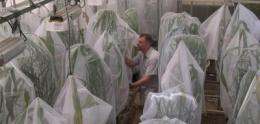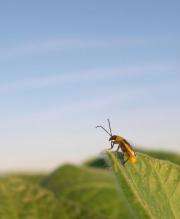Miscanthus, a biofuels crop, can host western corn rootworm

The western corn rootworm beetle, a pest that feasts on corn roots and corn silk and costs growers more than $1 billion annually in the U.S., also can survive on the perennial grass Miscanthus x giganteus, a potential biofuels crop that would likely be grown alongside corn, researchers report.
Rootworm beetle larvae can survive to adulthood on Miscanthus rhizomes, and adult beetles will lay their eggs at the base of Miscanthus plants grown near cornfields, the researchers found. Their study, in the Public Library of Science journal PLoS ONE, is the first to identify Miscanthus as a host of the corn rootworm.
The research team, from the University of Illinois Natural History Survey, tested several rootworm beetle populations on Miscanthus, adding rootworm eggs to potted Miscanthus and corn plants in a greenhouse setting. Rootworms from all populations survived to adulthood on the Miscanthus plants, including a strain that is behaviorally resistant to crop rotation. (Rather than remaining true to cornfields, rotation-resistant rootworms also will lay their eggs in soybean fields and other rotated crops, allowing the larvae to feed on corn planted in those fields the following spring.)
"The rotation-resistant rootworm is the population that is most familiar and troublesome to farmers in Illinois," said Joseph Spencer, an insect behaviorist at the State Natural History Survey and co-author on the study with former Survey scientist Sathyamurthy Raghu.
"This form is spreading across the Corn Belt, putting a greater area of U.S. corn production at risk each year. The worst rootworm was happy on Miscanthus," Spencer said.
Although the researchers found about 70 percent fewer adult rootworm beetles on the Miscanthus plants than on the corn plants grown in the greenhouse, the fact that rootworms could survive at all on this perennial grass was a revelation, Spencer said.
"That we can get as many insects as we were getting tells us that this plant is not a bad host for these insects," he said.

Some adults emerged from the Miscanthus slightly earlier than they appeared on corn. More emerged slightly later than those on corn, Spencer said, but the timing of their emergence was close enough that "there's the possibility that adults coming off these two crops could interact."
This interaction could be good or bad for corn growers, Spencer said. If the rootworms that grow up on Miscanthus carry genes that make them susceptible to transgenic corn or to insecticides used on corn and they mate with rootworm beetles in a cornfield, it could help slow development of resistance to insecticides or transgenic corn among their offspring. On the other hand, the acres devoted to Miscanthus could function as a vast, perennial reservoir of rootworm beetles - with devastating consequences for corn growers.
To determine if the western corn rootworm would lay its eggs in a Miscanthus field, the researchers placed potted Miscanthus plants in rows next to a cornfield during the egg-laying period. Late in the season, before the corn was harvested but after the rootworm adults were all dead, the researchers counted rootworm eggs in the soil around the corn and Miscanthus plants, and in the space between the rows of plants.
"There was no difference in the mean number of western corn rootworm eggs laid at the base of Miscanthus and maize in the field," the authors wrote.
The implications for corn growers are not yet known, "but these findings brought it home to us that much more study is needed," Spencer said. "Before we put something out in the environment that could result in pest problems increasing on corn, we need to more fully appreciate the ecology and potential interactions in the environment."
More information: Spencer JL, Raghu S (2009) Refuge or Reservoir? The Potential Impacts of the Biofuel Crop Miscanthus x giganteus on a Major Pest of Maize. PLoS ONE 4(12): e8336. doi:10.1371/journal.pone.000833
Provided by University of Illinois at Urbana-Champaign


















